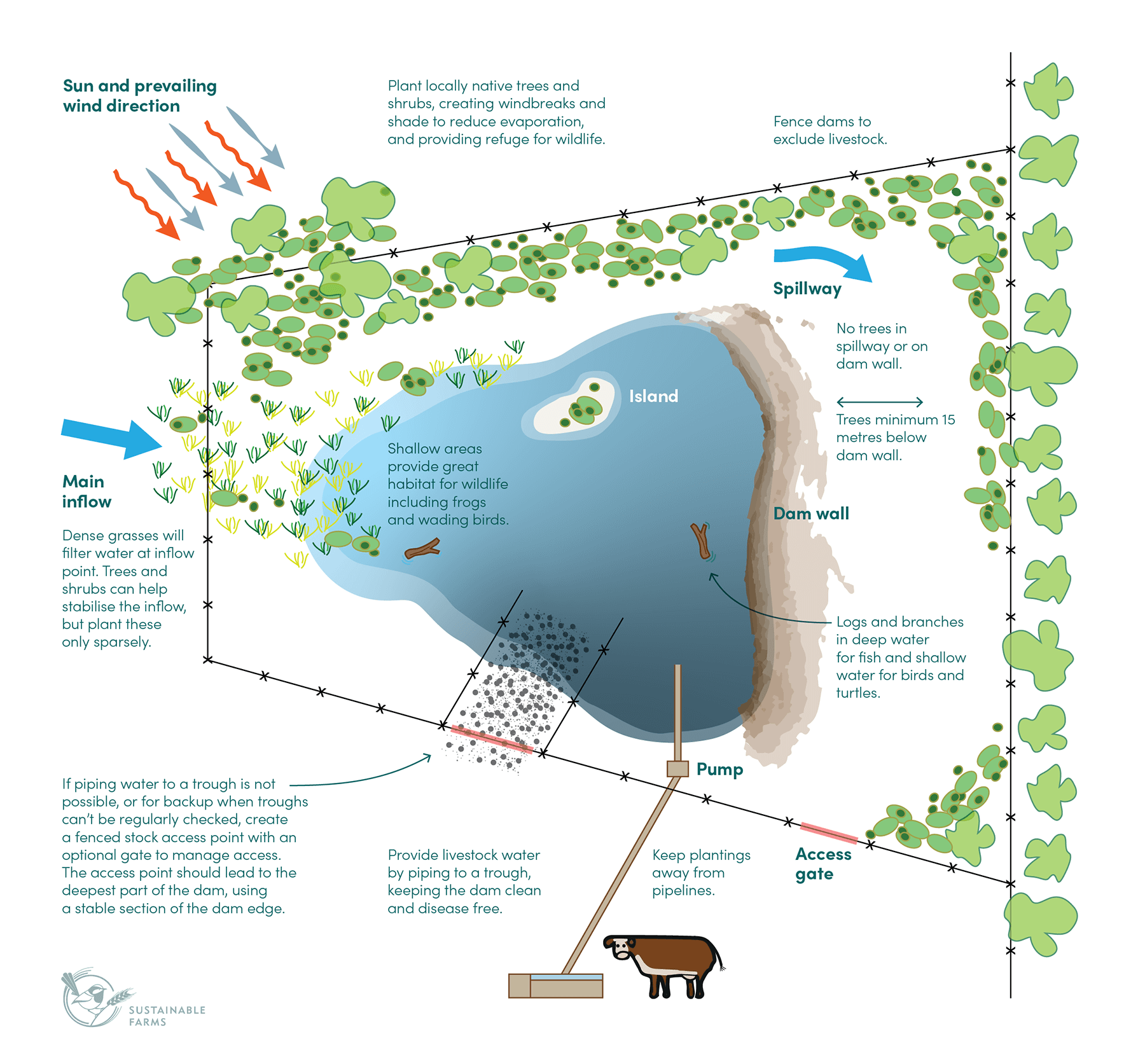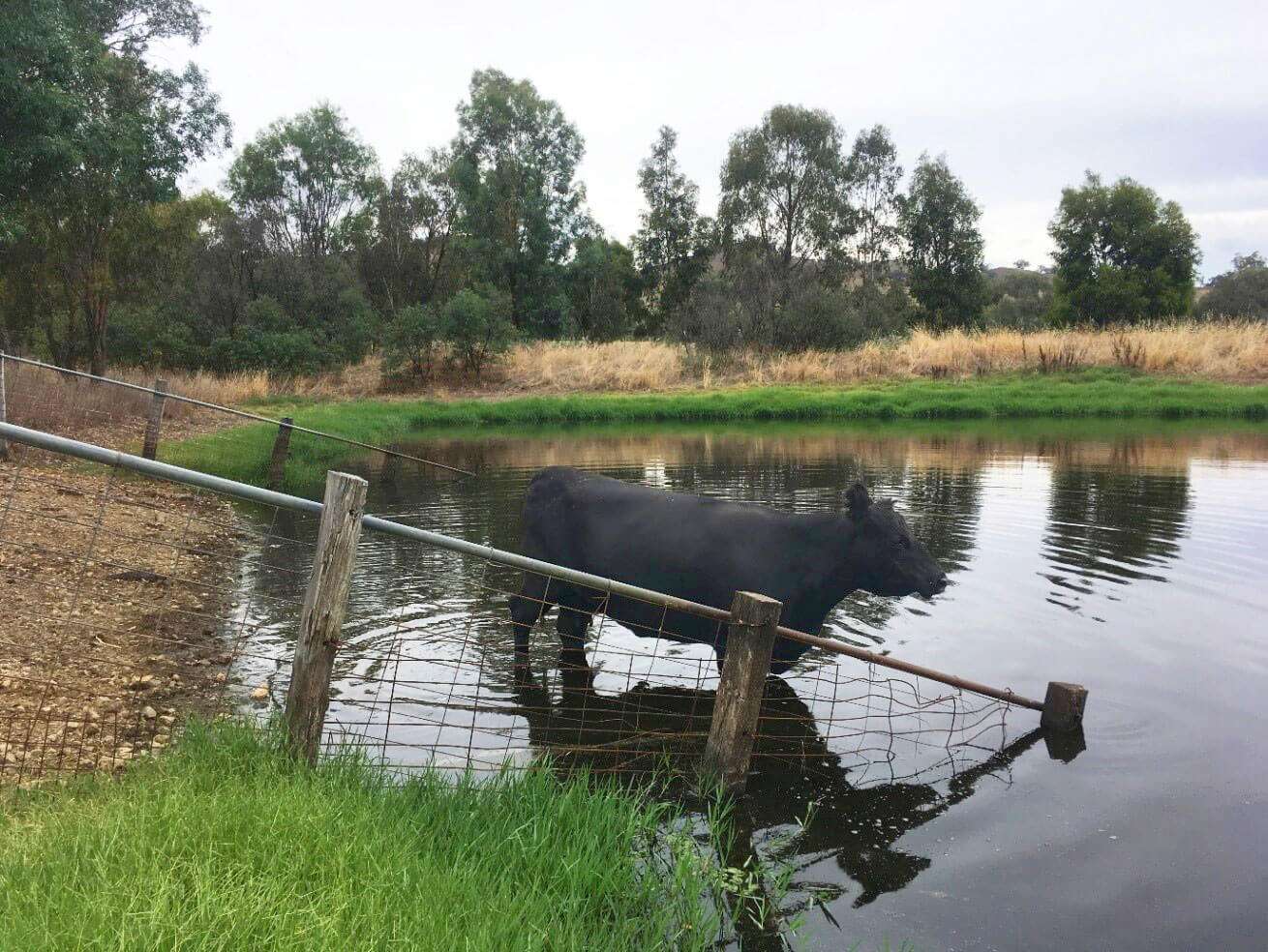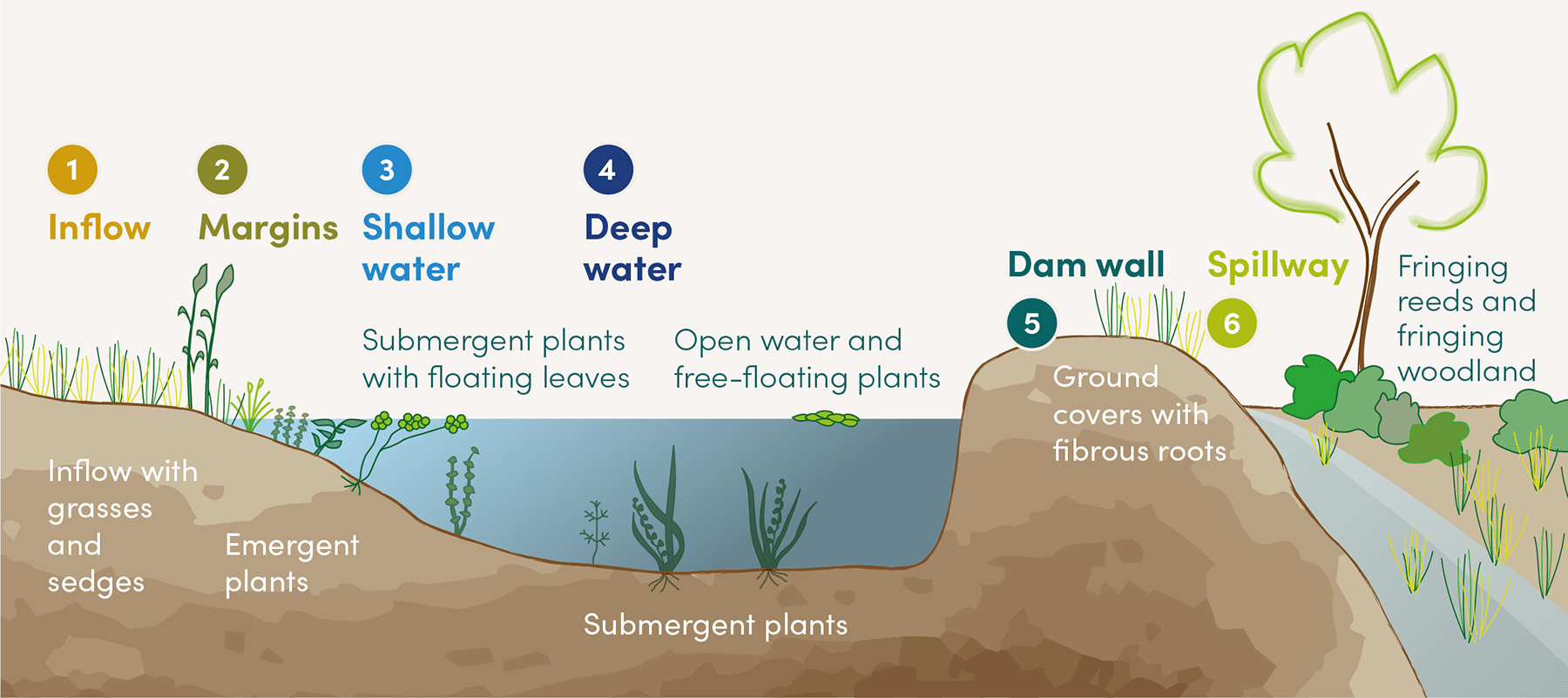How to enhance a farm dam
There are four key aspects to enhancing a farm dam:
- Grazing management
- Provision of alternative stock watering points
- Revegetation
- Habitat features to support biodiversity
The various features of an enhanced dam are illustrated in Figure 3.

Figure 3: Key features of an enhanced farm dam.
Grazing management
Reducing grazing intensity in the dam catchment, particularly in the immediate vicinity of the dam, will reduce the inflow of faeces, nutrients and sediment. This occurs in two ways:
- Removing stock from the immediate vicinity reduces the amount of faeces that can end up the dam;
- Reducing grazing pressure enables the growth of vegetation around the dam, which provides a filtration buffer.
Fencing
Fencing the area around the dam is the simplest way to exclude stock from the dam. Considerations for fencing a dam include:
- Aim to fence at least 10m back from the highwater mark of the dam. This provides sufficient room for a grass filter and to plant other vegetation, as well as room for effective management.
- Include a gate into the fenced area to allow access when needed.
- Connecting new fences to existing fence lines can reduce costs.
- If possible, avoid using barbed wire on fences (particularly the top strand) around areas such as dams that are likely to attract wildlife – gliders and some birds are vulnerable to being caught on barbed wire.
- Be aware of potential stock movement around a new fence – stock tracks can be created along fencelines which can then deflect water flow, particularly in flat country.
- Be prepared to manage weeds and competing grasses such as Phalaris inside the fenced area for the first year to allow other vegetation to establish. Sensitive management is required to ensure ground cover is retained throughout this transition.
Hardened access point
A hardened access point is a fenced raceway with a hard surface that enables access to the dam for stock in the adjoining paddock (Figure 4). While complete stock exclusion from a dam is ideal, a hardened access point with a gate, provides flexibility at times when troughs can’t be regularly checked, such as when going on holidays.
Position
- Hardened access points should be located away from the inflow, spillway and dam wall. Avoid particularly steep areas of the batter.
- Stock prefer water at or below body temperature, so choosing a deeper or shaded area to allow access can ensure stock have cooler water.
Construction
- Hardened access points can only be constructed effectively when the water level in the dam is low. The fence needs to run far enough into the dam that stock can’t get around it when the water level is low. Old tires can be used effectively to create a fenced access.
- Hardened access points are usually 6-10m wide, depending on numbers of stock requiring access.
- Hardening the surface of the dam access point is important to stop the area becoming boggy and fouling the water. It also encourages stock to move away once they have finished drinking.
- Options for hardening the surface include laying gravel or stone, which is especially effective if laid on geofabric, or concreting the surface. Excavation of the access point to a depth of 10cm may be required to create a flat access point that won’t erode.
- If a hardened access is installed purely as a backup, a gate at the top of the access can enable it to be closed off when not required.

Figure 4: Example of a hardened access point.
Manage the dam catchment area
As well as protecting the immediate vicinity of a dam, careful management of the surrounding paddocks can also help limit the flow of sediment, nutrients and faeces into the water body. Aim to:
- Maintain high ground cover to avoid soil erosion and sedimentation of the dam. At least 80% vegetation cover is recommended and use of deep-rooted perennial grasses can help stabilise soils. 1
- De-intensify agricultural production in the dam catchment as much as possible, 2 for example by limiting tillage and the use of fertilisers and pesticides, especially during wet periods.
Provide alternative access to water
Ideally, a dam will be fully fenced and a reticulated water system installed to provide water points for stock. This is the best way to enhance the condition of the dam for maximum water quality and long-term water security. A hardened access point can also be used to allow managed stock access to a dam, minimising pugging and sedimentation, as well as reducing the amount of time stock spend in or on the edge of the water.
Reticulated water systems
Supplying water to livestock using troughs and reticulated water systems has some clear advantages in terms of water quality and water efficiency, and can also provide added flexibility for paddock management.
Once a farm water budget has been established, work backwards from what stock need to design a water supply system. A well-designed system, with properly-selected components and good installation will create a system that can last for a long time.
Flow rate
Stock don’t usually visit a trough consistently throughout the day – there is likely to be a rush in the morning and again in the afternoon. This means water pipes, valves and troughs all need to be able to deliver all the water required over a four hour period (not over 24 hours).
Given this, calculate a required flow rate in L/min or L/day. Assuming that the water supply can deliver the required amount, then size the pump to suit the flow rate and required pressure.
Pipes
The pipes that carry water from source to stock is often not considered, but is vital. The pipes must have the right pressure rating to withstand the pressure delivered by the pump, but must also have a large enough diameter. Water in pipes has friction, which reduces with increased pipe size, but increases with a longer distance. Therefore delivering water over a longer distance requires a larger diameter pipe to avoid choking the system.
Trough design
For troughs to successfully provide adequate water to stock, the following must be considered 3
- Access: is the trough accessible on all sides?
- Size: is the trough large enough for enough stock to access it at the same time, and to ensure that dominant animals don’t crowd out the less dominant? See tables 1 and 2 for size guidelines.
- Height: round troughs are often too high for young calves or sheep to access.
- Flow rate: the trough needs to be able to refill fast enough to provide enough water for stock during peak demand.
Table 1: Size guidelines for rectangular troughs
| Trough length – metres (feet) | Sheep per trough | Cattle per trough |
| 2.4m (8’) | 310 | 70 |
| 3.6m (12’) | 470 | 110 |
| 4.8m (16’) | 620 | 140 |
For every 1 metre of trough length (where stock can access both sides of the trough), allow approximately 30 cows or 130 sheep.
Table 2: Size guidelines for round troughs
| Trough diameter – metres (feet) | Sheep per trough | Cattle per trough |
| 1.3m (4’4”) | 260 | 60 |
| 1.4m (4’9”) | 290 | 70 |
| 2.0m (6’8”) | 410 | 90 |
| 3.0m (10’) | 610 | 140 |
Trough types and materials
- Concrete troughs are robust, hard for stock to move, keeps water cool and is fire resistant, but is harder to keep clean.
- Polyethylene troughs are easier to move around, non-porous so easy to clean, but not fire resistant.
- Fibreglass and galvanised steel are less commonly used.
Other things to consider:
- Protect the trough fittings and inlet pipe from potential damage by stock.
- Ensure the poly line feeding the trough is buried, to avoid the water in the line heating up.
- Keep troughs clean and free of contaminants by regularly cleaning them out.
- Troughs can still be useful even in a paddock with an unfenced dam. Installing a gravity fed stock trough downslope of the dam (away from the drainage line) can reduce stock wanting to drink from the dam, and thereby reduce pressure on the unfenced dam.
Revegetation
Revegetating the area around a dam with appropriate species will help filter run-off containing sediment and nutrients and therefore improve water quality.
Once a dam is fenced and livestock are excluded, many species of aquatic plants and fringing rushes and sedges will naturally re-establish, as these species have long-lived seeds that will be present in the soil. However, active revegetation may be required to establish native trees and shrubs around the dam.
Different zones of a dam are suited to different types of vegetation (Figure 5). See the Sustainable Farms guide Enhancing farm dams: What to plant in and around your dam for more detailed information.

Figure 5: Cross-section of a dam showing dam zones and vegetation types.
Aquatic vegetation
Revegetating the dam water body provides additional habitat for micro-organisms, insects, frogs, fish and birds. Aquatic animals, particularly birds, may introduce propagules of aquatic plants into a dam but active replanting can speed the process of colonisation.
Floating plants such as Azolla and pondweed ( Potamogeton species), and emergent plants such as water plantain ( Alisma plantago-aquatica ) and cumbungi ( Typha domingensis ) provide perches for invertebrates, frogs and small birds. They also shade the water surface, reducing the amount of sunlight reaching the water surface and heating the dam. Planting emergent plants such as reeds near the dam inflow can also improve the quality of water entering the dam.
Submergent plants root in the sediment of the dam and may exist entirely underwater or have floating leaves. Some species will grow in shallower parts of the dam and others will colonise deeper parts. Plants whose entire structure remains below the water require sufficient light penetration to survive so low turbidity is essential.
Inflow and spillway
These areas should have a dense ground cover of grasses and forbs that will filter the water entering the dam and reduce erosion of the spillway. Sedges and rushes can also be appropriate, but be careful that they do not become too dense in the spillway as they may compromise the ability of the spillway to carry water away from the dam.
Keeping these areas free of trees and shrubs will allow the ground cover to develop faster, as well as permitting the free flow of water.
Dam margins
Dam margins are the area between the high- and low-water line, so will typically be inundated after rain events but may often also be dry. This area should be revegetated by plants tolerant to periodic wetting and drying, such as rushes and sedges. Frogs, dragonflies and waterbirds (such as crakes and rails) favour such margins of water bodies.
Dam wall
Plant the dam wall with native forbs and perennial grasses with fibrous root systems to reduce soil erosion. Suitable native plants include spear grasses ( Austrostipa species ), wallaby grasses ( Rytidosperma species ) and prostrate spreading plants such as Hardenbergia .
It is very important to avoid planting trees or larger shrubs as their root systems can compromise the structural integrity of the dam wall.
Dam walls can be challenging to revegetate. Ideally, the topsoil would have been saved when the dam was built, and spread across the surface of the dam wall after construction, but this has often washed away leaving compacted clay which is difficult for plants to establish on. Physical structures such as logs, branches, coir fibre or mesh, or a mulch of hay or straw, can be placed on the wall to reduce soil erosion while plants establish.
Surrounding terrestrial vegetation
Trees and shrubs provide important habitat around the dam and will encourage small woodland birds, arboreal marsupials and invertebrates to use the site for foraging, breeding and refuge. This vegetation also provides shade and reduces windspeeds, reducing evaporation.
As a rule of thumb, trees and shrubs should be located at least 5m away from the high water mark of the dam, orientated to provide shade and a windbreak for the water body (Figure 3). Wider plantings make more effective windbreaks than narrow strip plantings and provide more habitat for native biodiversity.
Seek advice from your local Landcare group, Local Land Services (NSW) or Catchment Management Authority (Victoria) for advice on which native plant species are most appropriate for your location.
Additional features to support biodiversity
Depth variation
A dam with varying depths provides a range of habitat zones for aquatic life.
A deep borrow pit – the main excavated area of the dam – is important for water storage and retention, and deeper parts of the dam will provide a persistent reservoir of cooler water.
Shallow shelves are important for enabling aquatic vegetation to establish. This vegetation will play an important role in filtering inflow, keeping the water cleaner and providing habitat for wildlife. A shallow extension to an existing dam can be added relatively cheaply at the inflow end, where it can also serve as a sediment trap, reducing water turbidity in the main body of the dam.
Logs and islands
Partially submerged logs provide perches above the water surface where invertebrates and turtles can perch and frogs can use to call from. Below the surface, logs provide a surface upon which aquatic micro-organisms and algae can grow which in turn provide food for some fish and aquatic invertebrates.
Islands provide a safe haven for turtles and waterbirds to bask and nest on, free from interference by predators. Establishing plants on and around islands increases the area of vegetation for phytoremediation (the purification of water through the metabolic actions of plants), improves the microbial flora of the dam and provides additional habitat for aquatic or semi-aquatic organisms such as fish, frogs, turtles, waterbirds and native water rats.
Solid islands can be incorporated into the dam during construction but for existing dams, floating islands provide many of the same benefits.
Floating islands can be constructed from photo-stable plastic pipes or untreated wood such as pallets (check that they are marked HT (heat-treated) and are not chemically preserved). Clean plastic barrels or sealed plastic pipes secured beneath the island’s surface can improve flotation. Remember to allow sufficient flotation for the extra weight as vegetation establishes on the island. For a short video demonstrating an example of how to build a floating island, visit https://youtu.be/GO57w2jxwqQ
[1] NSW Government (2011) The Farm Dam Handbook . NSW Govt, Sydney. https://www.waternsw.com.au/__data/assets/pdf_file/0008/113687/FarmDamFinalLR.pdf
[2] Davies, BR, Biggs, J, Williams, PJ, Lee, JT & Thompson S (2008) A comparison of the catchment sizes of rivers, streams, ponds, ditches and lakes: implications for protecting aquatic biodiversity in an agricultural landscape. Hydrobiologia 597(1): 7-17. https//doi.org/10.1007/s10750-007-9227-6
[3] South East Local Land Services, Farm Water Series – Water troughs video: https://www.lls.nsw.gov.au/regions/south-east/key-projects/farm-water

